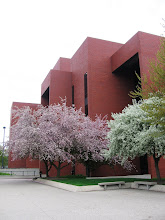Throughout the University Libraries, the computer workstations are always busy. Wherever you look, no matter what floor you are on, students are working individually or cooperatively in small and large groups on their scholarly pursuits and class projects that include creating documents and presentations, performing literature searches, checking assignment updates on Blackboard, viewing streaming video, engaging in videoconferencing, or performing a host of other educative activities. Students can also be seen staying in contact with friends and family via e-mail or instant messenger utilities and even participating in educational simulations and gaming.
This prompted me to wonder, “During an average session on one of the Libraries’ workstations, how much time do our students spend?”
In order to determine the answer to this question, James W. Hammons, Head of Library Technologies, analyzed data collected automatically by the Libraries from our 368 computer workstations. He selected the 54-day period of Monday, January 11 through Friday, March 5, 2010. In all, he analyzed 143,557 computer sessions for this period using statistical software such as SPSS and Excel.
Jim’s objective was to determine the median time that students spent at a workstation in Bracken Library and at the two branch libraries, the Architecture Library and the Science-Health Science Library. Additionally, by analyzing data by any given area within the University Libraries, he wanted to determine if students spent different amounts of time depending upon the location of where they chose to study.
The median was selected as the average measure since outliers at the extremes of the data do not influence it. That is, a very large value or small value cannot overly influence the median unlike it can the mean. Jim’s findings proved to be informative.
Analysis of the Median Time Spent at Workstations by Area
The accompanying bar graph and table (page 3) depict the breakdown by floor or area within the University Libraries. Overall, the median time spent by students using any of the Libraries’ 368 computer workstations was 22.1 minutes.
• Bracken’s Quiet Zone fourth floor (41 workstations available) — Students spent the longest median time here, 50.7 minutes.
• Bracken’s third floor (71 workstations) — Students working in small groups tend to be attracted to this area. The median time spent was 47.6 minutes.
• Bracken’s first floor east side (39 workstations) — In this relatively quiet area, the median time spent was 40.7 minutes.
• Bracken’s first floor west (105 workstations) — Often referred to as the Reference Learning Center because of its proximity to the Reference Desk, this area is the most visible to Bracken’s visitors and hosts most of the public printers. The median time was 18.8 minutes.
• Science-Health Science Library (11 workstations) — Median session time was 20.1 minutes.
• Architecture Library (14 workstations) — Median session time was 11.8 minutes.
Conclusion
These data show that ambience influenced by location is a prime factor in how students select computer workstations for use in the University Libraries. When students are working on activities that require
in-depth study, extended research, writing, and intricate computational analyses, among other tasks, they choose Bracken’s fourth floor Quiet Zone or some other generally quiet areas like first floor east, with its refined, artful decor. If they are working collaboratively, the third-floor cluster of workstations is a popular choice due to its projection as a collective study space.
The branch libraries and Bracken’s Reference area have proven to be highly functional places. Students stop in before or between classes to make final adjustments to assignments, printing papers or class notes, checking Blackboard or e-mail, posting remarks to Facebook, scanning drawings for projects, or reviewing course reserves, to name a few of the many endeavors that are being pursued.
For all of these activities, the University Libraries provide a setting to accommodate student’s needs by making it easy to access computer workstations and course-oriented software. The median time students spent at the workstations more than suggest that the workstations are an integral element for our student’s research, learning, and scholarly achievement.
We invite members of the academic community to visit the University Libraries often for their research and learning needs. ◙
Labels: best place to study, computing



